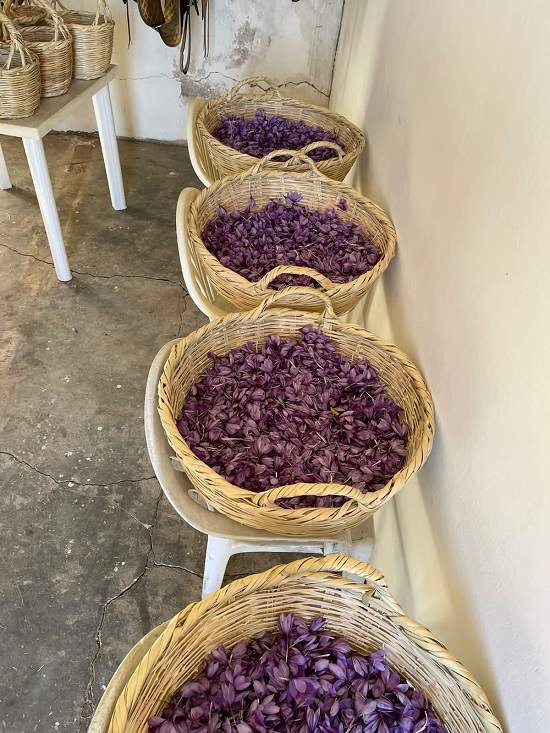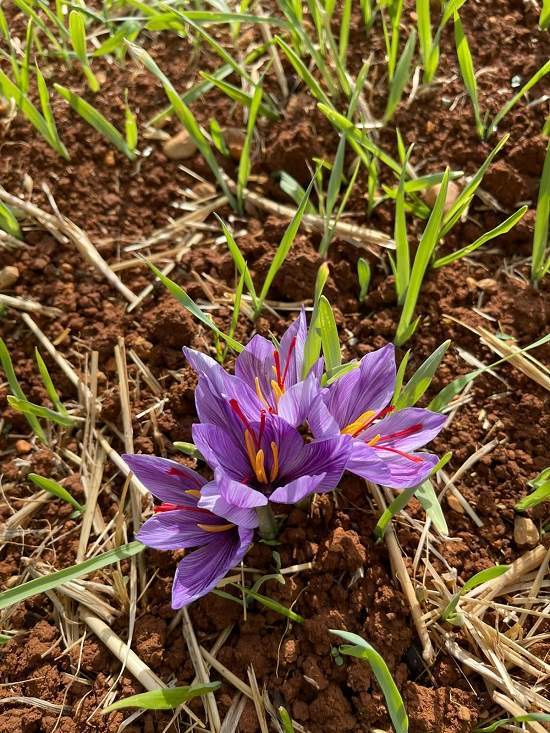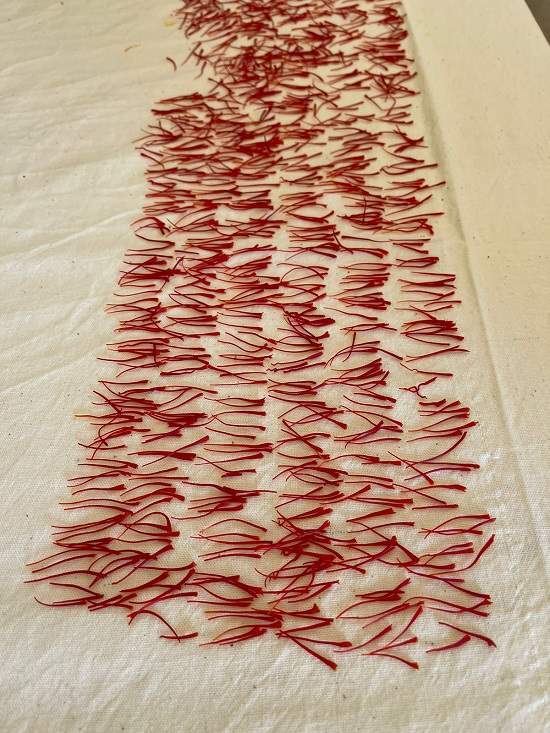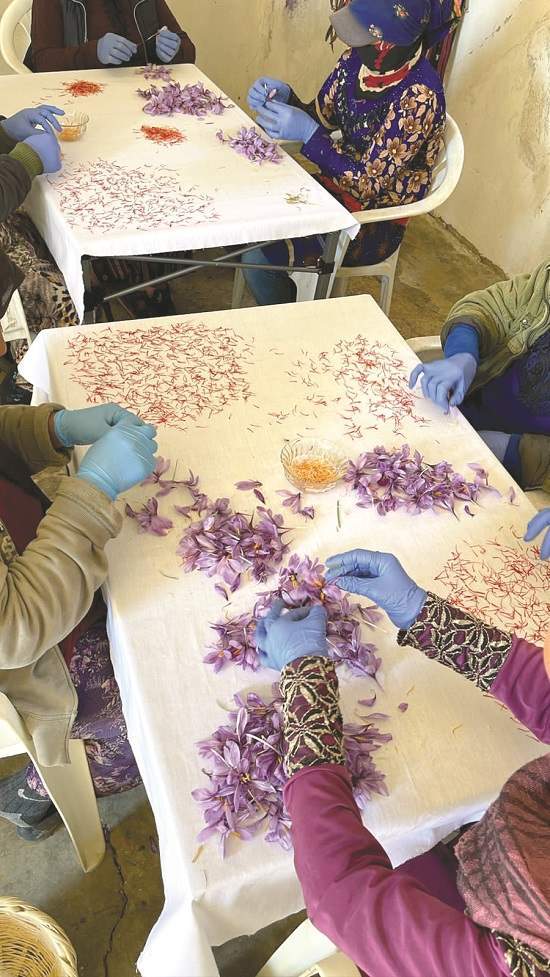BEIRUT — Architects
Jihad Farah and Karl Karam met at anti-government protests which erupted in
Lebanon in October 2019. Both men were facing tough times, new construction had slowed due to the
financial crisis, and both were looking for a new project to help generate income and help in their country’s development. Saffron cultivation was their answer.
اضافة اعلان
 A handful of saffron blossoms. (Photo: Handout from Jihad
Farah)
A handful of saffron blossoms. (Photo: Handout from Jihad
Farah)
Although they have not yet started commercial operations, their first year’s planting has yielded 170gs of pure dried Saffron; next year, they aim to treble or quadruple that quantity. Farah said that their 6.5 dunum piece of land in the Bekaa Valley, near the village of Hizzine, should yield on average 1.4kgs of Saffron annually.
Since their project got media attention, they have been swamped with calls of support and people offering to add their own land holdings to the project. “Thousands of square meters of land were offered to us to grow saffron on, and people were calling to ask how they can support us, but we are taking it one step at a time,” Farah told
Jordan News.
 Saffron crops collected. (Photo: Handout from Jihad Farah)
Saffron crops collected. (Photo: Handout from Jihad Farah)
In two to three weeks’ time, the results of tests carried out on samples of their saffron crop should be in from labs in Germany. Based on those results, the pair will take the next step toward commercial exploitation of saffron and possible export abroad.
 Saffron blossoms. (Photo: Handout from Jihad
Farah)
Saffron blossoms. (Photo: Handout from Jihad
Farah)
“There are two kinds of tests; first, the chemical composition of the saffron strands are tested, then there is the professional chef’s eye that determines the quality of the strands,” Farah added. Their aim is to produce top quality locally grown saffron.
“We used to arrive in the fields before everyone else, the saffron blossoms have to be picked before the sun hits them. We remove the red strands from the flowers the same day and then put them out on clean sheets to dry in the open air,” Farah said.
 Saffron blossoms. (Photo: Handout from Jihad
Farah)
Saffron blossoms. (Photo: Handout from Jihad
Farah)
At first, their neighbors were curious about this new kind of crop and asked all sorts of questions; now everyone in the area is excited about the project’s potential.
The picking season for saffron blossoms is very short, it started October 29 and ended by the end of November. “When we came to see our first crop we didn’t know what we would find, as we arrived at the field and found the purple blooms, it was a pleasant surprise,” Farah said.
 Neat rows of saffron stands. (Photo: Handout
from Jihad Farah)
Neat rows of saffron stands. (Photo: Handout
from Jihad Farah)
The pair are not in a hurry and they have bigger plans than just the cultivation of saffron spice, they aim to find uses for the flower itself, possibly in the making of soaps or candles, and add a creative design aspect to their project.
“After a while we can receive visitors who can have the complete experience of picking, and plucking, and drying their own saffron,” Farah said. “The area has good vibes, you are bounded by both the Mount Lebanon and Eastern Mountain ranges. The dry nature of the Bekaa is also very useful, it helps dry the saffron strands quickly.”
 Separating red saffron strands from the flower.
(Photo: Handout from Jihad Farah)
Separating red saffron strands from the flower.
(Photo: Handout from Jihad Farah)
His partner, Karam, started thinking of Saffron as a potential crop long before the protests erupted in Lebanon and the financial crisis bit hard. “My family owned some farmland in Batroun, and we were thinking of planting crops,” Farah said. “Our land was small, but Saffron doesn’t require a large amount of land.”
Both Farah and Karam got to know another person who had started a similar saffron project a few years ago but had abandoned it. The land was still available, and 100,000 saffron bulbs were already there, so they came to an agreement with this person, who now lives in
Switzerland, and they proceeded to revive the saffron project.
“We studied how to improve the quality of the saffron and how to pick the flowers as fast as possible, and how to efficiently pluck the red strands. We still do not know the quality of the saffron crop, we sent samples to labs in Germany and are waiting for the results,” Farah said.
 Separating red saffron strands from the flower.
(Photo: Handout from Jihad Farah)
Separating red saffron strands from the flower.
(Photo: Handout from Jihad Farah)
Their creative, design-oriented nature, being architects by training, comes out in the pair’s attention to detail when planting as well. “We measured the furrows very carefully so that each one was exactly parallel to the other,” Farah said. This also helps workers walking up and down the field to pick the flowers without stepping on other blossoms on their way.
“We will not go into the market before we are certain of the quality of the saffron. We will then package and market the saffron ourselves,” Farah said, adding that they also aim to get ISO certification for their saffron.
Read more Lifestyle



